Stained Glass and its Environment
Dan Humphries
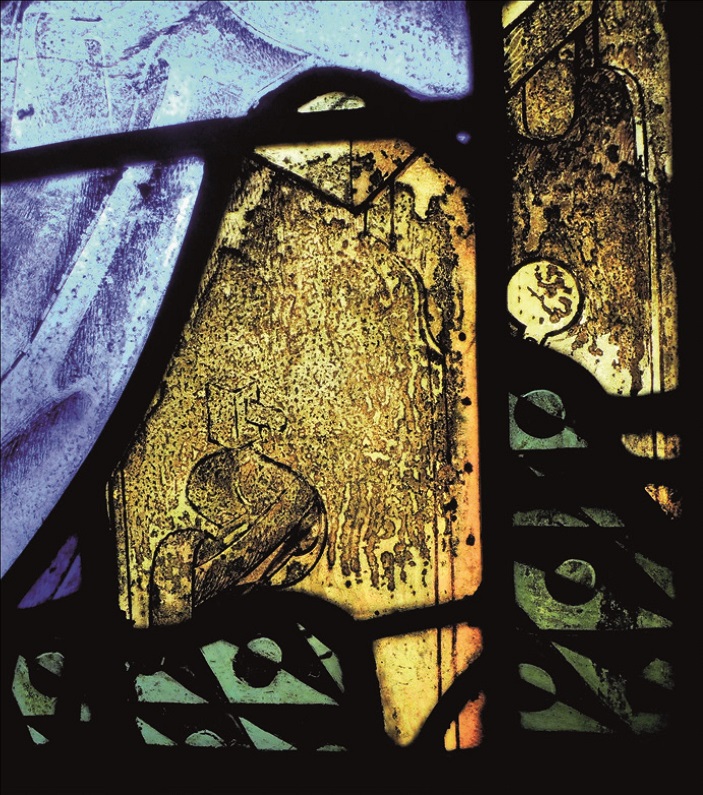 |
||
| Severe corrosion of a 16th-century glass surface caused by condensation. (All photos: Dan Humphries) |
Stained glass adorns most of our ecclesiastical buildings and many of our historic secular buildings. As well as being objects of architecture, adornment, illustration and beauty that can tell us about the time and often place they were made, stained glass windows are also, critically, part of the building envelope. As such they must keep out wind, rain, bats, insects and draughts while also keeping in warmth. In short, the glazing has to keep the inside in and the outside out while usually being the thinnest, most thermally conductive and physically fragile part of that envelope. Indeed, stained glass has only a few millimetres of thickness with which to separate two climates that can be very different, most critically (in terms of the subject of this article) in temperature.
WETTING OF STAINED GLASS
Air contains water vapour. Inside a church moisture is drawn into the air from damp masonry, from the floors, from flower arrangements, parishioners’ breath, damp coats and a hundred other sources. The warmer the air, the more water vapour it can hold. If a church’s heating is left off all week and then switched to full power on the morning of a service, the warmer post-service air will be able to hold far more moisture than before. As it cools, all this surplus moisture will condense, with the most condensation occurring on the coldest surfaces.
As a building with great mass, a typical church will warm and cool slowly compared to the external environment where temperatures will typically peak and trough every 24 hours, so temperatures can differ significantly between inside and outside even without any heating. There will be cooler temperatures outside than inside for most of the night and when this is the case, the stained glass, being an excellent thermal conductor will present a cool inner face to the interior of the church. As the cooling, sluggish air meets the face of the stained glass it chills further, potentially reaching dew point (at which water can no longer be maintained as vapour) and the moisture condenses on the inner face of the stained glass forming droplets. When the sun rises the following morning, it will hit the church on its south and east elevations, warming the glass quickly and causing the condensation to evaporate again. On the north side of the church however, the windows are not warmed by the morning sun. North-facing windows can stay wet for days during a condensation event in winter.
As well as this wetting by condensation, the external face of stained glass is susceptible to wetting by precipitation – rain.
CORROSION
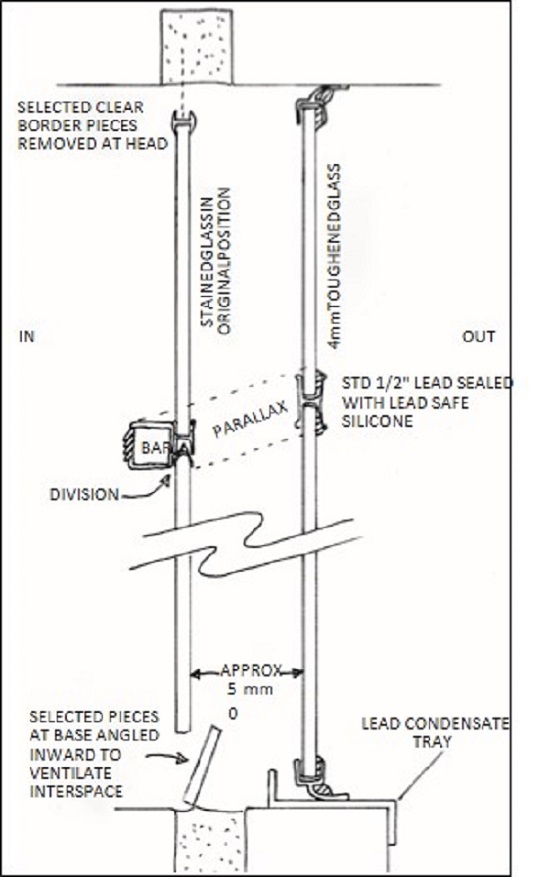 |
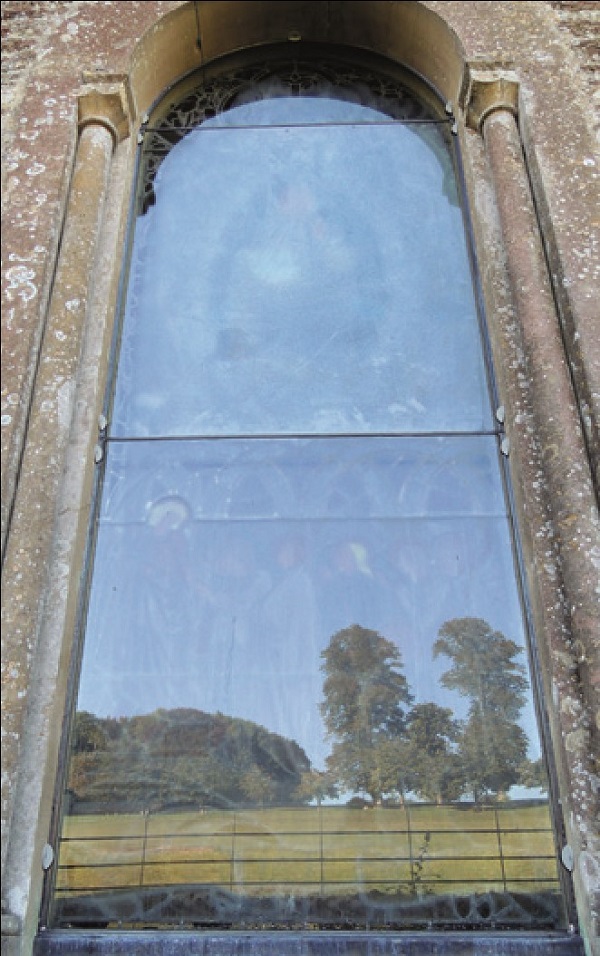 |
| An EPG design – in this case the stained glass remains where it is and is ventilated in situ, and the new glazing plane is to the exterior. | The reflection caused by using large sheets of glass for environmental protective glazing would usually pose a significant problem, but this elevation was only visible from farmland. |
Most of us think of glass as waterproof but that assumption is not altogether true. Known as the gel layer, a zone at the very surface of the glass often just micrometres thick can be considered porous to water.
Within this layer chemical interaction between water and the constituents of the glass take place, most importantly the leaching of some alkaline fluxes used to lower the melting temperature of glass during its manufacture. Medieval glass with a high potash content is especially susceptible to this leaching, the result of which can be pitting or blanket corrosion on the glass surface. This corrosion can be disfiguring as the corrosion products can be opaque. In severe cases the glass can be eaten right through.
PAINT LOSS
The detail in stained glass is added with the use of vitreous glass paints. These are composed of metal oxide pigments, usually iron and or copper and finely ground glass frit. The paint is applied to the individual pieces of glass and kiln fired. The addition of a flux allows the glass frit to melt at a lower temperature than the glass body, bonding the pigment to the heat-softened glass surface permanently. In the latter half of the 19th century, a boom time for the stained glass industry, kiln technology was improved leading to more rapid firings and paint recipes were experimented with in a bid to improve results and increase productivity. A common side effect of that innovation is that glass paint on Victorian windows can be under-fired or chemically water soluble. Both lead to the loss of painted detail when wet and 150 years later, many Victorian stained glass windows have become virtually illegible.
ENVIRONMENTAL PROTECTIVE GLAZING (EPG)
Formerly known as isothermal glazing, EPG was developed in Austria and Germany in the second half of the 20th century as a means of protecting medieval stained glass from condensation and thus corrosion, and it has been in use in the UK for the past 50 years or so. Its development and acceptance here owes much to Keith Barley of Barley Studios in York and Sebastian Strobl, formerly of Canterbury Cathedral. It is now widely acknowledged as the best way of preventing wetting of stained glass, and hence halting or greatly reducing corrosion and paint loss.
EPG is discussed in greater detail in the article by Robyn Pender on page 20, but in essence it involves the introduction of a second, sealed layer of glass outside of the historic glazing, with the interspace ventilated to the inside of the building through vents placed at the top and bottom of each light. As the interspace is warmed or cooled by variations in the external temperature, the air rises or falls, drawing in fresh air from inside the building, creating a flue effect in the interspace. A more consistent temperature is thus maintained to both sides of the stained glass, preventing or reducing the instances of condensation on it. Condensation which will often occur on the secondary glazing is channelled to the outside of the building through weep holes at the base and across a lead apron laid over the sill.
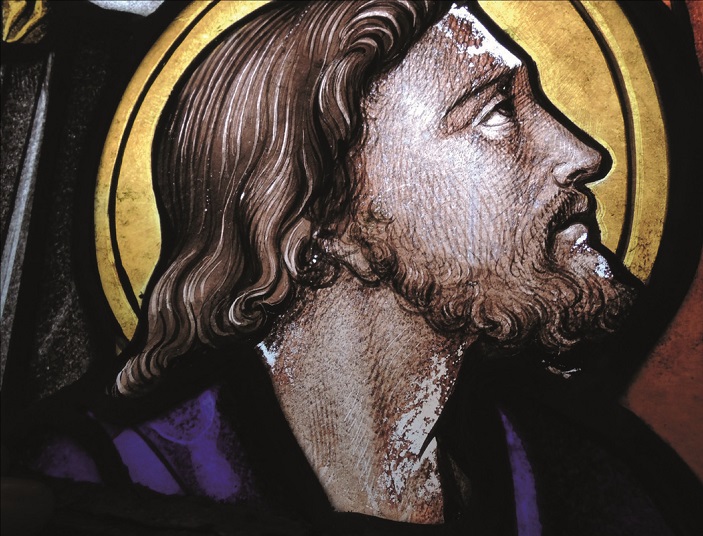 |
||
| Detail of a window by Eleanor Vere Boyle and made by Willement showing loss of 19th-century painted detail typical of a north elevation window. |
EPG does not require any power to work, nor does it need opening or closing by the parishioners. In fact it doesn’t require anything more than occasional cleaning and maintenance to continue working effectively once fitted. Described like this, EPG sounds too good to be true but it is not without its drawbacks: moving the original stained glass is a significant intervention and, if badly designed, it can have a negative impact on the external appearance of a building. Seen from the outside, stained glass presents a rich, textured surface that shimmers as the observer passes and changes with the time of day, year and the weather. Hiding this under large sheets of flat glass inevitably presents clinically flat reflections that look out of place on historic buildings, while the use of leaded glass in the EPG can cause parallax problems when viewed from inside. Some alterations will also be required to the stained glass itself, whether it is relocated inwards or left in its present position and vented, and the need for secure fixings for the new glazing means drilling into the surrounding historic fabric.
The cost of a large EPG scheme often makes a period of environmental monitoring desirable for funding bodies, both before the project to confirm the need for EPG, and after installation to confirm that it is working as intended.
CASE STUDY - ST LEONARD'S, MARSTON BIGOT, SOMERSET
St Leonard’s is a small, rural church near Frome in Somerset. It sits next to Marston Hall, home of the Earls of Cork and Orrery from the 1640s to the early 20th century, and the current church and its stained glass is a result of their benefaction. The five nave windows (three south and two north) are by Thomas Willement FSA, heraldic glass artist to George IV and later artist in glass to Queen Victoria. The east window contains an important collection of 16th-century glass from France and Germany, arranged into their current configuration by Willement during a major restoration of the 1840s. The deterioration of the groups of windows is typical of their age and orientation within the church.
For the purposes of this article the glazing can be grouped thus:
Nave south windows: three figurative windows by Willement; Salvator Mundi, St Peter and St John.
These south-facing windows were the initial cause for concern for the parish. As a result of deterioration of the lead matrix and its ties, two of the panels had started separating and slowly migrating downwards.
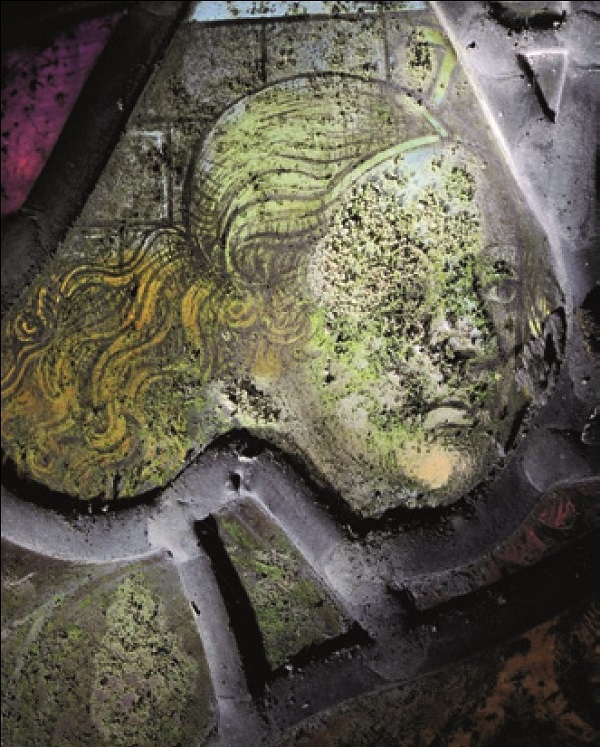 |
||
| Internal algal growth, an indicator of regular wetting. |
Deterioration of the lead matrix (as in this case) or bowing of panels is typical of stained glass in south-facing elevations as it is regularly exposed to extremes of temperature. The glass, support bars, ties and guards were all found to be original. The windows were removed and carefully conserved before being reinstalled. We fitted small stainless steel plates, powder-coated black to the bars at the panel divisions to help support the weight of the panels.
Nave north windows: two windows designed by Eleanor Vere Boyle and made by Willement. Affectionately known as EVB, Eleanor, was the wife of Richard Cavendish Boyle, the rector for some 40 years and son of the 8th Earl. She was a highly accomplished artist and illustrator and the instigator of the 1840s restoration. Early in her married life she illustrated two successful children’s books. She used income earned from these books to pipe water to Lower Marston, to replace the roof of St Leonard’s and to pay for these two windows.
The deterioration of these windows was typical of north-facing windows, especially those made in the 19th century. Although very similar in their construction and installation to the three south-facing windows, the lead matrix was found to be sound. The main issue was paint loss as a result of prolonged wetting from condensation due to the windows’ northerly situation.
East window: a celebrated collection of 16th-century glass from Flanders and the Rhineland, extensively described by Michael McGarvie in the church’s guidebook, by Cannon Christopher Woodforde in his book Stained Glass in Somerset, and by Nikolaus Pevsner. The collection is believed to have been given by the 8th Earl of Cork for the 1840s restoration.
Although the windows were found to be structurally sound, having been releaded since their installation, there was corrosion to both faces of the glass.
Decision making
As stated earlier, it is often desirable to allow a period of environmental monitoring before installation of an EPG system to confirm its need. Where a large complex environment is being investigated such as a cathedral, with adjustable heating and ventilation regimes and staff on hand to implement any variations, there is potential to learn much from environmental monitoring and to save money by altering the environment rather than installing EPG.
For a small church like St Leonard’s with limited funds, where the cost of environmental monitoring can prove prohibitive, other means of assessing the conditions may provide sufficient evidence of an ongoing problem. We humans come equipped with inbuilt temperature and RH sensors: although not very accurate, we can tell on walking into a church if the air feels cold and damp and there are usually visual indicators to corroborate. In this case the north and east windows both had healthy, green algal colonies on the inner painted face of the glass (illustrated on the previous page). Algae need a damp or wet environment to survive, so if there is green algal growth on a surface, it’s reasonable to assume that regular wetting is occurring. EPG was therefore recommended for the two north windows and the east window.
EPG design
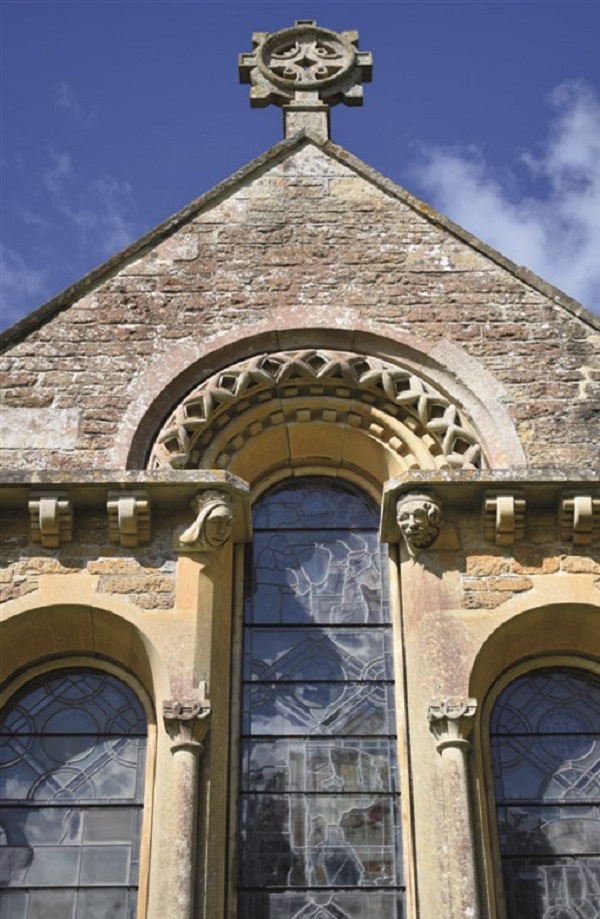 |
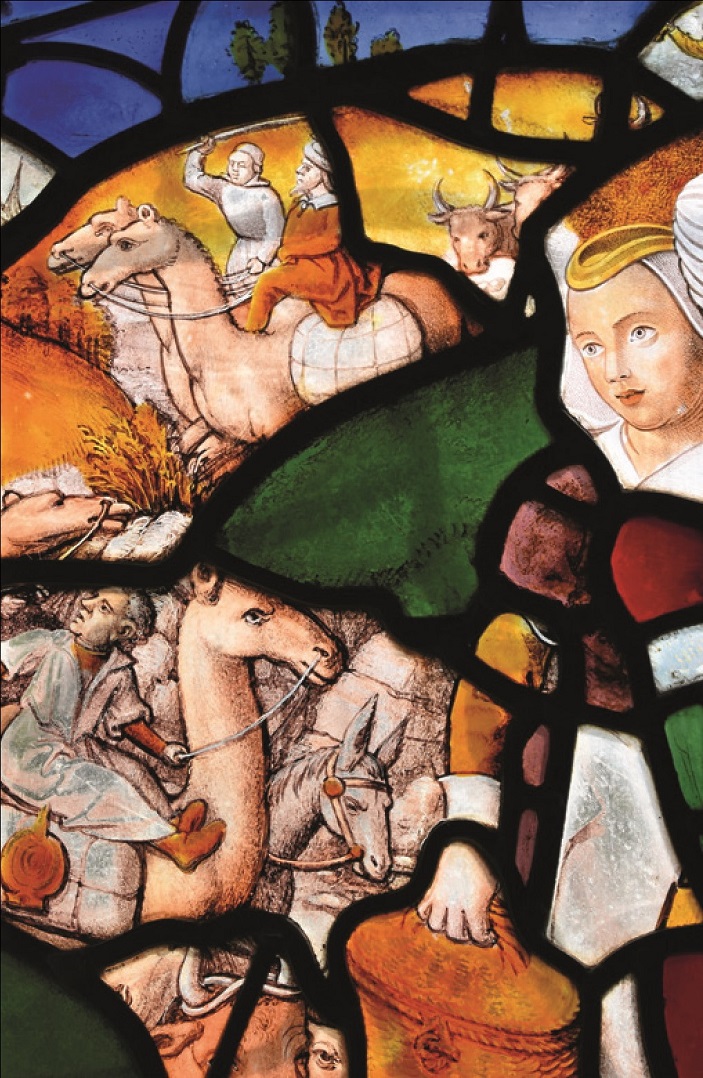 |
| The completed EPG to the east window at St Leonard’s, Marston Bigot, and (right) a detail of the 16th-century stained glass just behind, seen from the inside. | |
From a design perspective, installation of EPG to the north elevation was not problematic as the churchyard to the north is unused and the windows face a field, so large economical sheets of toughened float glass could be used for the external glazing. The stained glass was retained in its original position with vents fitted at the heads and bases and the external glazing was fixed to the external reveal, sealed with lead at the perimeters giving an interspace of 50mm.
Installation of EPG to the east window needed careful consideration. The car park lies to the east of the church and the first view most visitors have will be of this elevation. Indeed, the path leads you right past the east window as you approach the south door. It was decided that the EPG should mimic the external appearance of the stained glass; that is to say that it should be leaded, following the major lead-lines of the stained glass. Rubbings were taken of the existing lead matrix and unpainted areas noted so that parallax adjustments could be made. Glass samples, painted and unpainted were taken to site and compared to the window surface and a sample leaded panel was made, again for comparison on site before EPG design was finalised. After close comparison, kiln softened horticultural and antique glasses were lightly painted to mimic the appearance of the stained glass. The stained glass was removed for careful cleaning and to install vents at the heads and bases before being re-fixed in its original position. The leaded secondary glazing panels were fitted to the external reveal with an interspace of 50mm.
Post installation monitoring has taken the form of site visits and observation. It has been gratifying to find the EPG running wet and channelling water to the outside of the building while the historic glazing remained dry.
However, the success of the project owes much to the churchwarden, Angela Yeoman and the PCC and to the church’s inspecting architect, Marcus Chantrey of Benjamin and Beauchamp Architects.



